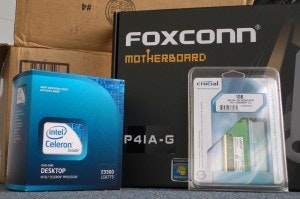“The customers have changed, and we have to as well.” – Anonymous Intel employee
Intel Corporation (NASDAQ:INTC) is certainly in a transitional period. With its CEO, Paul Otellini,announcing his retirement plans in November, and the accelerating decline of PC sales, Intel is fighting to keep up with the competition. While the new CEO has yet to be named, where he or she will take the company is quite evident. These are three key areas for Intel’s future growth.
Mobile

Intel Corporation (NASDAQ:INTC) has the advantages of chip design expertise and the best process technology in the world. The company plans to roll out new 22 nm smartphone chips later this year, which will provide significant energy efficiency advantages over its previous 32 nm designs and Taiwan Semiconductor Mfg. Co. Ltd. (ADR) (NYSE:TSM)’s 28 nm designs.
Taiwan Semiconductor Mfg. Co. Ltd. (ADR) (NYSE:TSM), one of the largest chip manufacturers in the world and a leader in mobile chips, is trying its best to leapfrog Intel. Instead of working on 22 nm chips, the company jumped down to a 20 nm process, which it just started testing using an ARM-Holdings design. TSMC expects its 20 nm chips to hit the market in high volume by 2014, but it likely won’t be until the second half of the year.
By that point, QUALCOMM, Inc. (NASDAQ:QCOM), NVIDIA Corporation (NASDAQ:NVDA), and other TSMC clients will have to compete with upcoming 14 nm chips from Intel, which should go into high-volume production by the beginning of 2015. Smartphone chips will likely lag behind by a few months, however, so Intel Corporation (NASDAQ:INTC)’s next CEO will need to convince manufacturers its chips are worth the wait.
Servers
As internet use continues to grow and mobile devices are being used to collect an expanding amount of data, there is a need for better servers to process all the information as efficiently as possible. Last week, Intel unveiled a re-engineering of the server, which provides a more cost-efficient solution. Intel wants to separate out all the components of a server room – CPUs, memory, storage – so that companies can upgrade components a la carte instead of having to overhaul the whole system.
Additionally, Intel’s 22 nm architecture is already being used in designs for Hewlett-Packard Company (NYSE:HPQ)’s upcoming “Project Moonshot” server cartridges. Power efficiency is a major concern in server chips due to their increasing proliferation and high energy costs for companies. Hewlett-Packard Company (NYSE:HPQ) isn’t exclusively using Intel chips, however. Project Moonshot partners also include Texas Instruments Incorporated (NASDAQ:TXN), Calxeda, Applied Micro Circuits Corporation (NASDAQ:AMCC), and longtime Intel rival Advanced Micro Devices, Inc. (NYSE:AMD).
While Advanced Micro Devices, Inc. (NYSE:AMD) got trounced by Intel in the home PC market, it’s begun carving out a good-sized niche in the ultra-low-power server market. Last year, the company acquired microserver company SeaMicro for approximately $334 million. The company is also working on extremely power efficient APU-like chips (which combine a CPU and graphics unit on one chip) called Heterogeneous System Architecture. These chips may prove valuable for graphic intense cloud servers processing things like streaming video.
Intel Corporation (NASDAQ:INTC) faces a lot of competition in this space, and its advantages aren’t quite as clear to allow it to dominate the market. Old partners like HP aren’t as loyal as they once were, so Intel will need to continue innovating in the space to prove its value and increase its popularity.
Ultrabooks
While the PC market is shrinking, ultrabooks look like the next progression for personal computing — 50% of computer purchasers are content creators, a craft that doesn’t lend itself well to tablets. Despite a slow response to ultrabooks in 2011, Intel increased its portfolio from 20 to 140 ultrabook designs last year. What’s more, Intel’s chips can be found in the most popular ultrabook competitor – Apple’s Macbook Air.
Intel Corporation (NASDAQ:INTC) is working to develop chips that provide better power-efficiency and lower costs. The company expects that by the end of the year, it will be able to extend an ultrabook’s battery life to 13 hours, while reducing the price on the low end to $599. Comparatively, in the 2011 ultrabook cycle battery life maxed out around 7 hours and the prices were rarely below $1,000.
With ultrabooks, Intel has all the advantages it has in the mobile space in addition to already controlling a dominant market share. Technically, Intel controls 100% of the ultrabook market share, and always will because it trademarked the term “Ultrabook.”
ARM-holdings is expected to enter the market this year, and Advanced Micro Devices, Inc. (NYSE:AMD) will likely do the same with its HSA technology. Without the ultrabook name at their disposal, however, it will take a lot of marketing power to overcome Intel, and I simply don’t see that happening.
Intel’s next CEO will need to do a lot to ensure that the new low-end ultrabook devices make customers excited. These are the devices that will go head-to-head with the iPad and Microsoft’s Surface on both features and price. It needs to add touch screens and extend the low-end devices battery lives, but more importantly, it needs to compete with the competitors huge marketing campaigns.
A lot to process
While the next CEO of Intel Corporation (NASDAQ:INTC) is still unknown, the direction the company is headed looks positive. It will be up to the new appointee to execute a plan that drives further growth in the above three areas. The company can’t just rely on its superior technology and design; it needs strong leadership to bring the company’s innovations to the market. We’ll find out soon who Intel has chosen, and what exactly he or she plans to do to change the company to fit its changing customers.
Adam Levy has no position in any stocks mentioned. The Motley Fool recommends Intel. The Motley Fool owns shares of Intel.

